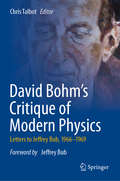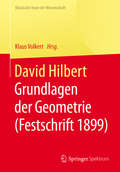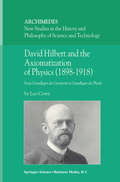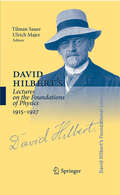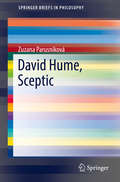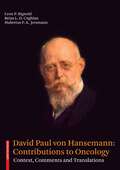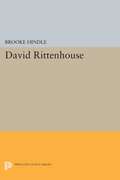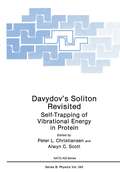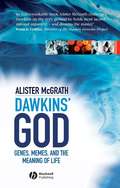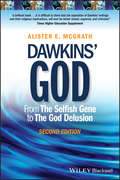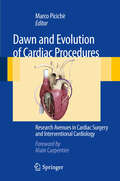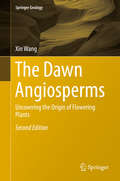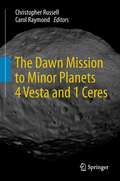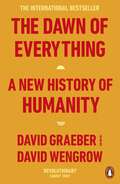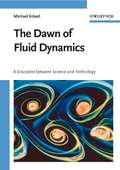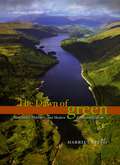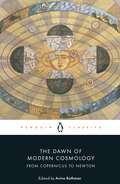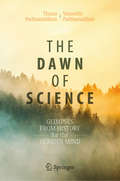- Table View
- List View
David Bohm's Critique of Modern Physics: Letters to Jeffrey Bub, 1966-1969
by Chris TalbotIn the letters contained in this book, David Bohm argues that the dominant formal, mathematical approach in physics is seriously flawed. In the 1950s and 60s, Bohm took a direction unheard of for a professor of theoretical physics: while still researching in physics, working among others with Yakir Aharanov and later Jeffrey Bub, he also spent time studying “metaphysics”—such as Hegel’s dialectics and Indian panpsychism. 50 years on, questions raised about the direction and philosophical assumptions of theoretical physics show that Bohm’s arguments still have contemporary relevance.
David Hilbert: Grundlagen der Geometrie (Festschrift 1899) (Klassische Texte der Wissenschaft)
by Klaus VolkertOriginaltext und historischer und mathematischer Kommentar von Klaus VolkertDavid Hilberts „Festschrift“ Grundlagen der Geometrie“ aus dem Jahre 1899 wurde zu einem der einflussreichsten Texte der Mathematikgeschichte. Wie kein anderes Werk prägte es die Mathematik des 20. Jahrhunderts und ist auch heute noch von größtem Interesse.Aus der Perspektive eines Mathematikhistorikers schildert der Herausgeber die Entwicklung einer Axiomatik der Geometrie, die spätestens mit Euklids „Elemente“ (ca. 300 v. u. Z.) begann und erst durch Hilbert zu einem vollständigen und handhabbaren System geführt wurde. Nach einer ausführlichen Erläuterung des Hilbertschen Textes wird seine Rezeption bis 1905 umfassend dargestellt und daran anschließend viele der von ihm ausgehenden weiteren direkten und indirekten Entwicklungen skizziert.Die Faszination des Textes ist auch dem heutigen Leser direkt zugänglich, da Hilbert´s axiomatischer Ansatz ohne mengentheoretische Argumente oder formale Logik auskommt.
David Hilbert and the Axiomatization of Physics: From Grundlagen der Geometrie to Grundlagen der Physik (Archimedes #10)
by L. CorryDavid Hilbert (1862-1943) was the most influential mathematician of the early twentieth century and, together with Henri Poincaré, the last mathematical universalist. His main known areas of research and influence were in pure mathematics (algebra, number theory, geometry, integral equations and analysis, logic and foundations), but he was also known to have some interest in physical topics. The latter, however, was traditionally conceived as comprising only sporadic incursions into a scientific domain which was essentially foreign to his mainstream of activity and in which he only made scattered, if important, contributions. Based on an extensive use of mainly unpublished archival sources, the present book presents a totally fresh and comprehensive picture of Hilbert’s intense, original, well-informed, and highly influential involvement with physics, that spanned his entire career and that constituted a truly main focus of interest in his scientific horizon. His program for axiomatizing physical theories provides the connecting link with his research in more purely mathematical fields, especially geometry, and a unifying point of view from which to understand his physical activities in general. In particular, the now famous dialogue and interaction between Hilbert and Einstein, leading to the formulation in 1915 of the generally covariant field-equations of gravitation, is adequately explored here within the natural context of Hilbert’s overall scientific world-view. This book will be of interest to historians of physics and of mathematics, to historically-minded physicists and mathematicians, and to philosophers of science.
David Hilbert's Lectures on the Foundations of Physics 1915-1927: Relativity, Quantum Theory and Epistemology
by Arne Schirrmacher Heinz-Jürgen SchmidtThese documents do nothing less than bear witness to one of the most dramatic changes in the foundations of science. The book has three sections that cover general relativity, epistemological issues, and quantum mechanics. This fascinating work will be a vital text for historians and philosophers of physics, as well as researchers in related physical theories.
David Hume, Sceptic (SpringerBriefs in Philosophy)
by Zuzana ParusnikováThis book studies Hume’s scepticism and its roots, context, and role in the philosopher’s life. It relates how Hume wrote his philosophy in a time of tumult, as the millennia-old metaphysical tradition that placed humans and their cognitive abilities in an ontological framework collapsed and gave way to one that placed the autonomy of the individual in its center. It then discusses the birth of modernity that Descartes inaugurated and Kant completed with his Copernican revolution that moved philosophy from Being to the Self. It shows how modernity gave rise to a new kind of scepticism, involving doubt not just about the adequacy of our knowledge but about the very existence of a world independent of the self. The book then examines how Hume faced the sceptical implications and how his empiricism added yet another sceptical theme with the main question being how argument can legitimize key concepts of human understanding instinctively used in making sense of our perceptions. Placing it firmly in a historical context, the book shows how Hume was influenced by Pyrrhonian scepticism and how this becomes clear in Hume’s acceptance of the weakness of reason and in his emphasis on the practical role of philosophy. As the book argues, rather than serving as the foundation of science, in Hume’s hand, philosophy became a guide to a joyful, happy life, to a documentary of common life and to moderately educated, entertaining conversation. This way Hume stands in strong opposition to the (early) modern mainstream.
David Paul von Hansemann: Context, Comments and Translations
by Leon P. Bignold Brian L. Coghlan Hubertus P.A. JersmannIn the late nineteenth century, David Paul von Hansemann coined phrases that have remained the basis of descriptive terms concerning the microscopical appearances of tumors ever since, yet his work is rarely mentioned today. This book presents translations of all the relevant German texts and analyses the background and context of Hansemann's theories. It shows that some of Hansemann’s ideas may still be relevant to cancer research today.
David Rittenhouse (PDF)
by Brooke HindleOne of the great figures of the American Enlightenment, David Rittenhouse of Pennsylvania rose from his work as a mechanic and clockmaker of exquisite craftsmanship to informed, careful astronomy and effective experimental work in optics, magnetism, and psychology. This book shows how he applied his scientific ability to public projects and, eventually, to the establishment of a 'national mint', and how he used his increasing prestige to further crucial political objectives of the time. This man, considered a brilliant scientist by Franklin and Jefferson, was, according to Benjamin Rush, "one of the luminaries of the eighteenth century."Originally published in 1964.The Princeton Legacy Library uses the latest print-on-demand technology to again make available previously out-of-print books from the distinguished backlist of Princeton University Press. These editions preserve the original texts of these important books while presenting them in durable paperback and hardcover editions. The goal of the Princeton Legacy Library is to vastly increase access to the rich scholarly heritage found in the thousands of books published by Princeton University Press since its founding in 1905.
Davydov’s Soliton Revisited: Self-Trapping of Vibrational Energy in Protein (Nato Science Series B: #243)
by Peter L. Christiansen Alwyn C. ScottProceedings of a NATO ARW held in Thisted, Denmark, July 30-August 5, 1989
Dawkins' GOD: Genes, Memes, and the Meaning of Life
by Alister E. McGrathAlister E. McGrath is one of the world’s leading theologians, with a doctorate in the sciences. Richard Dawkins is one of the bestselling popular science writers, with outspoken and controversial views on religion. This fascinating and provoking work is the first book-length response to Dawkins’ ideas, and offers an ideal introduction to the topical issues of science and religion. Addresses fundamental questions about Dawkins’ approach to science and religion: Is the gene actually selfish? Is the blind watchmaker a suitable analogy? Are there other ways of looking at things? Tackles Dawkins’ hostile and controversial views on religion, and examines the religious implications of his scientific ideas, making for a fascinating and provoking debate Written in a very engaging and accessible style, ideal to those approaching scientific and religious issues for the first time Alister McGrath is uniquely qualified to write this book. He is one of the world’s best known and most respected theologians, with a strong research background in molecular biophysics A superb book by one of the world’s leading theologians, which will attract wide interest in the growing popular science market, similar to Susan Blackmore’s The Meme Machine (1999).
Dawkins' GOD: Genes, Memes, and the Meaning of Life
by Alister E. McGrathAlister E. McGrath is one of the world’s leading theologians, with a doctorate in the sciences. Richard Dawkins is one of the bestselling popular science writers, with outspoken and controversial views on religion. This fascinating and provoking work is the first book-length response to Dawkins’ ideas, and offers an ideal introduction to the topical issues of science and religion. Addresses fundamental questions about Dawkins’ approach to science and religion: Is the gene actually selfish? Is the blind watchmaker a suitable analogy? Are there other ways of looking at things? Tackles Dawkins’ hostile and controversial views on religion, and examines the religious implications of his scientific ideas, making for a fascinating and provoking debate Written in a very engaging and accessible style, ideal to those approaching scientific and religious issues for the first time Alister McGrath is uniquely qualified to write this book. He is one of the world’s best known and most respected theologians, with a strong research background in molecular biophysics A superb book by one of the world’s leading theologians, which will attract wide interest in the growing popular science market, similar to Susan Blackmore’s The Meme Machine (1999).
Dawkins' God: From The Selfish Gene to The God Delusion
by Alister E. McGrathA fully updated new edition of a critically acclaimed examination of the theories and writings of Richard Dawkins by a world-renowned expert on the relation of science and religion Includes in-depth analysis of Dawkins’ landmark treatise The God Delusion (2006), as well as coverage of his later popular works The Magic of Reality (2011) and The Greatest Show on Earth (2011),and a new chapter on Dawkins as a popularizer of science Tackles Dawkins’ hostile and controversial views on religion, and examine the religious implications of his scientific ideas including a comprehensive investigation of the ‘selfish gene’ Written in an accessible and engaging style that will appeal to anyone interested in better understanding the interplay between science and religion
Dawkins' God: From The Selfish Gene to The God Delusion
by Alister E. McGrathA fully updated new edition of a critically acclaimed examination of the theories and writings of Richard Dawkins by a world-renowned expert on the relation of science and religion Includes in-depth analysis of Dawkins’ landmark treatise The God Delusion (2006), as well as coverage of his later popular works The Magic of Reality (2011) and The Greatest Show on Earth (2011),and a new chapter on Dawkins as a popularizer of science Tackles Dawkins’ hostile and controversial views on religion, and examine the religious implications of his scientific ideas including a comprehensive investigation of the ‘selfish gene’ Written in an accessible and engaging style that will appeal to anyone interested in better understanding the interplay between science and religion
Dawn and Evolution of Cardiac Procedures: Research Avenues in Cardiac Surgery and Interventional Cardiology
by Marco PicichèMarco PicichèThe book provides a clear overview of the various research stages of cardiac surgery, interventional cardiology, and cardiac anesthesia. It also deals with recent advances in minimally invasive surgery, robotic surgery, and many other innovations introduced in this field. However, aim of this volume is not only to describe the evolution of the discipline, but also to give the occasion of revisiting old and forgotten ideas that could be used successfully also nowadays if supported by modern technologies. With contributions by renowned international experts, the volume will be a very useful tool for students, residents, cardiac surgery and anesthesia professionals, cardiologists, biomedical engineers, and researchers.
The Dawn Angiosperms: Uncovering the Origin of Flowering Plants (Springer Geology #121)
by Xin WangThis book discusses the controversial and conflicting hypotheses on the origin of angiosperms, which was generally assumed to be restricted to the Cretaceous and later ages. Since publishing the first edition of “The Dawn of Angiosperms” in 2010, several important advances have been made in this field of science, namely 1) the discovery of new fossil angiosperms from the Jurassic; 2) European researchers discovering angiosperm-like pollen from the Triassic; and most importantly 3) the discovery of a perfect flower from the Jurassic. All of these findings are at odds with the currently widely accepted evolutionary theories, and thus call upon us to critically reassess botanical theory. Accordingly, the new edition of this book not only includes more new fossil taxa, but also documents them in greater detail and corrects many commonly held misconceptions. In so doing, it makes related studies and teaching on the early history of angiosperms more realistic, concrete, and tangible, providing concrete fossil evidence as the basis for future research, and helping to distinguish the most accurate botanical hypotheses.
The Dawn Mission to Minor Planets 4 Vesta and 1 Ceres
by Christopher Russell Carol RaymondDawn is the first mission to orbit a main belt asteroid and the first scientific mission to use ion propulsion. Major objectives of this mission include mapping of the surfaces of 4 Vesta and 1 Ceres, determining its topography from stereo measurements, determining its mineralogy, measuring its elemental composition and obtaining gravity data. This book describes the Dawn mission, its exploration and scientific objectives, the instruments that accomplish those objectives, the operations plan and the education and outreach plan. It is directed to those studying asteroids and the evolution of the solar system. This volume will be a valuable reference for anyone who uses data from the instruments of the DAWN mission. Previously published in Space Science Reviews, Vol. 163/1-4, 2012.
The Dawn of Everything: A New History of Humanity
by David Graeber David Wengrow'Pacey and potentially revolutionary' Sunday Times'A boldly ambitious work ... entertaining and thought-provoking' Observer'Fascinating, thought-provoking, groundbreaking. A book that will generate debate for years to come' Rutger Bregman'This is not a book. This is an intellectual feast' Nassim Nicholas TalebFor generations, our remote ancestors have been cast as primitive and childlike - either free and equal, or thuggish and warlike. Civilization, we are told, could be achieved only by sacrificing those original freedoms or, alternatively, by taming our baser instincts. David Graeber and David Wengrow show how such theories first emerged in the eighteenth century as a reaction to indigenous critiques of European society, and why they are wrong. In doing so, they overturn our view of human history, including the origins of farming, property, cities, democracy, slavery and civilization itself.Drawing on path-breaking research in archaeology and anthropology, the authors show how history becomes a far more interesting place once we begin to see what's really there. If humans did not spend 95 per cent of their evolutionary past in tiny bands of hunter-gatherers, what were they doing all that time? If agriculture, and cities, did not mean a plunge into hierarchy and domination, then what kinds of social and economic organization did they lead to? The answers are often unexpected, and suggest that the course of history may be less set in stone, and more full of playful possibilities than we tend to assume.The Dawn of Everything fundamentally transforms our understanding of the human past and offers a path toward imagining new forms of freedom, new ways of organizing society. This is a monumental book of formidable intellectual range, animated by curiosity, moral vision and faith in the power of direct action.'A fascinating inquiry ... Challenging and illuminating' Noam Chomsky'Graeber and Wengrow have effectively overturned everything I ever thought about the history of the world. The most profound and exciting book I've read in thirty years' Robin D. G. Kelley
The Dawn of Fluid Dynamics: A Discipline Between Science and Technology
by Michael EckertThis is the first publication to describe the evolution of fluid dynamics as a major field in modern science and engineering. It contains a description of the interaction between applied research and application, taking as its example the history of fluid mechanics in the 20th century. The focus lies on the work of Ludwig Prandtl, founder of the aerodynamic research center (AVA) in Gottingen, whose ideas and publications have influenced modern aerodynamics and fluid mechanics in many fields. While suitable for others, this book is intended for natural scientists and engineers as well as historians of science and technology.
The Dawn of Green: Manchester, Thirlmere, and Modern Environmentalism
by Harriet RitvoLocated in the heart of England’s Lake District, the placid waters of Thirlmere seem to be the embodiment of pastoral beauty. But under their calm surface lurks the legacy of a nineteenth-century conflict that pitted industrial progress against natural conservation—and helped launch the environmental movement as we know it. Purchased by the city of Manchester in the 1870s, Thirlmere was dammed and converted into a reservoir, its water piped one hundred miles south to the burgeoning industrial city and its workforce. This feat of civil engineering—and of natural resource diversion—inspired one of the first environmental struggles of modern times. The Dawn of Green re-creates the battle for Thirlmere and the clashes between conservationists who wished to preserve the lake and developers eager to supply the needs of a growing urban population. Bringing to vivid life the colorful and strong-minded characters who populated both sides of the debate, noted historian Harriet Ritvo revisits notions of the natural promulgated by romantic poets, recreationists, resource managers, and industrial developers to establish Thirlmere as the template for subsequent—and continuing—environmental struggles.
The Dawn of Green: Manchester, Thirlmere, and Modern Environmentalism
by Harriet RitvoLocated in the heart of England’s Lake District, the placid waters of Thirlmere seem to be the embodiment of pastoral beauty. But under their calm surface lurks the legacy of a nineteenth-century conflict that pitted industrial progress against natural conservation—and helped launch the environmental movement as we know it. Purchased by the city of Manchester in the 1870s, Thirlmere was dammed and converted into a reservoir, its water piped one hundred miles south to the burgeoning industrial city and its workforce. This feat of civil engineering—and of natural resource diversion—inspired one of the first environmental struggles of modern times. The Dawn of Green re-creates the battle for Thirlmere and the clashes between conservationists who wished to preserve the lake and developers eager to supply the needs of a growing urban population. Bringing to vivid life the colorful and strong-minded characters who populated both sides of the debate, noted historian Harriet Ritvo revisits notions of the natural promulgated by romantic poets, recreationists, resource managers, and industrial developers to establish Thirlmere as the template for subsequent—and continuing—environmental struggles.
The Dawn of Green: Manchester, Thirlmere, and Modern Environmentalism
by Harriet RitvoLocated in the heart of England’s Lake District, the placid waters of Thirlmere seem to be the embodiment of pastoral beauty. But under their calm surface lurks the legacy of a nineteenth-century conflict that pitted industrial progress against natural conservation—and helped launch the environmental movement as we know it. Purchased by the city of Manchester in the 1870s, Thirlmere was dammed and converted into a reservoir, its water piped one hundred miles south to the burgeoning industrial city and its workforce. This feat of civil engineering—and of natural resource diversion—inspired one of the first environmental struggles of modern times. The Dawn of Green re-creates the battle for Thirlmere and the clashes between conservationists who wished to preserve the lake and developers eager to supply the needs of a growing urban population. Bringing to vivid life the colorful and strong-minded characters who populated both sides of the debate, noted historian Harriet Ritvo revisits notions of the natural promulgated by romantic poets, recreationists, resource managers, and industrial developers to establish Thirlmere as the template for subsequent—and continuing—environmental struggles.
The Dawn of Green: Manchester, Thirlmere, and Modern Environmentalism
by Harriet RitvoLocated in the heart of England’s Lake District, the placid waters of Thirlmere seem to be the embodiment of pastoral beauty. But under their calm surface lurks the legacy of a nineteenth-century conflict that pitted industrial progress against natural conservation—and helped launch the environmental movement as we know it. Purchased by the city of Manchester in the 1870s, Thirlmere was dammed and converted into a reservoir, its water piped one hundred miles south to the burgeoning industrial city and its workforce. This feat of civil engineering—and of natural resource diversion—inspired one of the first environmental struggles of modern times. The Dawn of Green re-creates the battle for Thirlmere and the clashes between conservationists who wished to preserve the lake and developers eager to supply the needs of a growing urban population. Bringing to vivid life the colorful and strong-minded characters who populated both sides of the debate, noted historian Harriet Ritvo revisits notions of the natural promulgated by romantic poets, recreationists, resource managers, and industrial developers to establish Thirlmere as the template for subsequent—and continuing—environmental struggles.
The Dawn of Green: Manchester, Thirlmere, and Modern Environmentalism
by Harriet RitvoLocated in the heart of England’s Lake District, the placid waters of Thirlmere seem to be the embodiment of pastoral beauty. But under their calm surface lurks the legacy of a nineteenth-century conflict that pitted industrial progress against natural conservation—and helped launch the environmental movement as we know it. Purchased by the city of Manchester in the 1870s, Thirlmere was dammed and converted into a reservoir, its water piped one hundred miles south to the burgeoning industrial city and its workforce. This feat of civil engineering—and of natural resource diversion—inspired one of the first environmental struggles of modern times. The Dawn of Green re-creates the battle for Thirlmere and the clashes between conservationists who wished to preserve the lake and developers eager to supply the needs of a growing urban population. Bringing to vivid life the colorful and strong-minded characters who populated both sides of the debate, noted historian Harriet Ritvo revisits notions of the natural promulgated by romantic poets, recreationists, resource managers, and industrial developers to establish Thirlmere as the template for subsequent—and continuing—environmental struggles.
The Dawn of Green: Manchester, Thirlmere, and Modern Environmentalism
by Harriet RitvoLocated in the heart of England’s Lake District, the placid waters of Thirlmere seem to be the embodiment of pastoral beauty. But under their calm surface lurks the legacy of a nineteenth-century conflict that pitted industrial progress against natural conservation—and helped launch the environmental movement as we know it. Purchased by the city of Manchester in the 1870s, Thirlmere was dammed and converted into a reservoir, its water piped one hundred miles south to the burgeoning industrial city and its workforce. This feat of civil engineering—and of natural resource diversion—inspired one of the first environmental struggles of modern times. The Dawn of Green re-creates the battle for Thirlmere and the clashes between conservationists who wished to preserve the lake and developers eager to supply the needs of a growing urban population. Bringing to vivid life the colorful and strong-minded characters who populated both sides of the debate, noted historian Harriet Ritvo revisits notions of the natural promulgated by romantic poets, recreationists, resource managers, and industrial developers to establish Thirlmere as the template for subsequent—and continuing—environmental struggles.
The Dawn of Modern Cosmology: From Copernicus to Newton
by Nicolaus Copernicus Galileo Galilei Johannes Kepler René Descartes Isaac NewtonNew to Penguin Classics, the astonishing story of the Copernican Revolution, told through the words of the ground-breaking scientists who brought it aboutIn the late fifteenth century, it was believed that the earth stood motionless at the centre of a small, ordered cosmos. Just over two centuries later, everything had changed. Not only was the sun the centre of creation, but the entire practice of science had been revolutionised. This is the story of that astonishing transformation, told through the words of the astronomers and mathematicians at its heart. Bringing together excerpts from the works and letters of Copernicus, Galileo, Kepler, Descartes, Newton and others for the first time, The Dawn of Modern Cosmology is the definitive record of one of the great turning points in human history.Edited with Translations, Notes and an Introduction by Aviva Rothman
The Dawn of Science: Glimpses from History for the Curious Mind
by Thanu Padmanabhan Vasanthi PadmanabhanThis lucid and captivating book takes the reader back to the early history of all the sciences, starting from antiquity and ending roughly at the time of Newton — covering the period which can legitimately be called the “dawn” of the sciences. Each of the 24 chapters focuses on a particular and significant development in the evolution of science, and is connected in a coherent way to the others to yield a smooth, continuous narrative. The at-a-glance diagrams showing the “When” and “Where” give a brief summary of what was happening at the time, thereby providing the broader context of the scientific events highlighted in that chapter. Embellished with colourful photographs and illustrations, and “boxed” highlights scattered throughout the text, this book is a must-read for everyone interested in the history of science, and how it shaped our world today.
